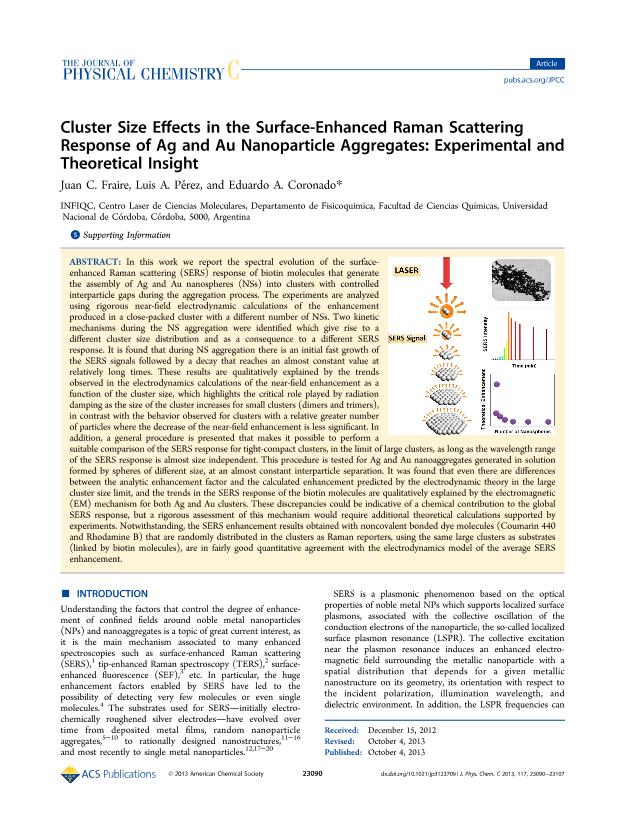Mostrar el registro sencillo del ítem
dc.contributor.author
Fraire, Juan Carlos

dc.contributor.author
Pérez, Luis Alberto

dc.contributor.author
Coronado, Eduardo A.

dc.date.available
2017-10-04T13:31:43Z
dc.date.issued
2013-10
dc.identifier.citation
Fraire, Juan Carlos; Pérez, Luis Alberto; Coronado, Eduardo A.; Cluster size Effects in the surface-enhanced Raman scattering response of Ag and Au nanoparticle aggregates: experimental and theoretical insight; American Chemical Society; Journal of Physical Chemistry C; 117; 44; 10-2013; 23090-23107
dc.identifier.issn
1932-7447
dc.identifier.uri
http://hdl.handle.net/11336/25836
dc.description.abstract
In this work we report the spectral evolution of the surface-enhanced Raman scattering (SERS) response of biotin molecules that generate the assembly of Ag and Au nanospheres (NSs) into clusters with controlled interparticle gaps during the aggregation process. The experiments are analyzed using rigorous near-field electrodynamic calculations of the enhancement produced in a close-packed cluster with a different number of NSs. Two kinetic mechanisms during the NS aggregation were identified which give rise to a different cluster size distribution and as a consequence to a different SERS response. It is found that during NS aggregation there is an initial fast growth of the SERS signals followed by a decay that reaches an almost constant value at relatively long times. These results are qualitatively explained by the trends observed in the electrodynamics calculations of the near-field enhancement as a function of the cluster size, which highlights the critical role played by radiation damping as the size of the cluster increases for small clusters (dimers and trimers), in contrast with the behavior observed for clusters with a relative greater number of particles where the decrease of the near-field enhancement is less significant. In addition, a general procedure is presented that makes it possible to perform a suitable comparison of the SERS response for tight-compact clusters, in the limit of large clusters, as long as the wavelength range of the SERS response is almost size independent. This procedure is tested for Ag and Au nanoaggregates generated in solution formed by spheres of different size, at an almost constant interparticle separation. It was found that even there are differences between the analytic enhancement factor and the calculated enhancement predicted by the electrodynamic theory in the large cluster size limit, and the trends in the SERS response of the biotin molecules are qualitatively explained by the electromagnetic (EM) mechanism for both Ag and Au clusters. These discrepancies could be indicative of a chemical contribution to the global SERS response, but a rigorous assessment of this mechanism would require additional theoretical calculations supported by experiments. Notwithstanding, the SERS enhancement results obtained with noncovalent bonded dye molecules (Coumarin 440 and Rhodamine B) that are randomly distributed in the clusters as Raman reporters, using the same large clusters as substrates (linked by biotin molecules), are in fairly good quantitative agreement with the electrodynamics model of the average SERS enhancement.
dc.format
application/pdf
dc.language.iso
eng
dc.publisher
American Chemical Society

dc.rights
info:eu-repo/semantics/openAccess
dc.rights.uri
https://creativecommons.org/licenses/by-nc-sa/2.5/ar/
dc.subject
Plasmonics
dc.subject
Sers
dc.subject
Au Nanoparticles Aggregates
dc.subject
Optical Properties
dc.subject.classification
Nano-materiales

dc.subject.classification
Nanotecnología

dc.subject.classification
INGENIERÍAS Y TECNOLOGÍAS

dc.title
Cluster size Effects in the surface-enhanced Raman scattering response of Ag and Au nanoparticle aggregates: experimental and theoretical insight
dc.type
info:eu-repo/semantics/article
dc.type
info:ar-repo/semantics/artículo
dc.type
info:eu-repo/semantics/publishedVersion
dc.date.updated
2017-10-03T18:23:54Z
dc.journal.volume
117
dc.journal.number
44
dc.journal.pagination
23090-23107
dc.journal.pais
Estados Unidos

dc.journal.ciudad
Washington DC
dc.description.fil
Fil: Fraire, Juan Carlos. Consejo Nacional de Investigaciones Científicas y Técnicas. Centro Científico Tecnológico Conicet - Córdoba. Instituto de Investigaciones en Físico-química de Córdoba. Universidad Nacional de Córdoba. Facultad de Ciencias Químicas. Instituto de Investigaciones en Físico-química de Córdoba; Argentina
dc.description.fil
Fil: Pérez, Luis Alberto. Consejo Nacional de Investigaciones Científicas y Técnicas. Centro Científico Tecnológico Conicet - Córdoba. Instituto de Investigaciones en Físico-química de Córdoba. Universidad Nacional de Córdoba. Facultad de Ciencias Químicas. Instituto de Investigaciones en Físico-química de Córdoba; Argentina
dc.description.fil
Fil: Coronado, Eduardo A.. Consejo Nacional de Investigaciones Científicas y Técnicas. Centro Científico Tecnológico Conicet - Córdoba. Instituto de Investigaciones en Físico-química de Córdoba. Universidad Nacional de Córdoba. Facultad de Ciencias Químicas. Instituto de Investigaciones en Físico-química de Córdoba; Argentina
dc.journal.title
Journal of Physical Chemistry C

dc.relation.alternativeid
info:eu-repo/semantics/altIdentifier/doi/http://dx.doi.org/10.1021/jp3123709
dc.relation.alternativeid
info:eu-repo/semantics/altIdentifier/url/http://pubs.acs.org/doi/abs/10.1021/jp3123709
Archivos asociados
